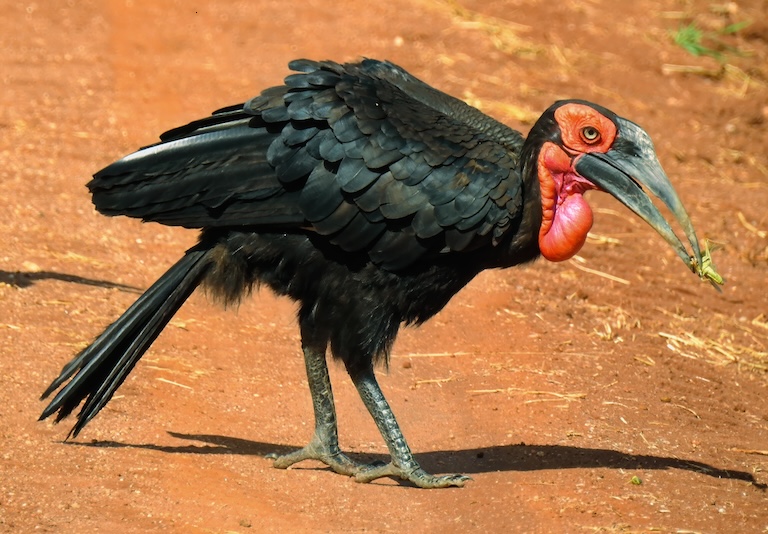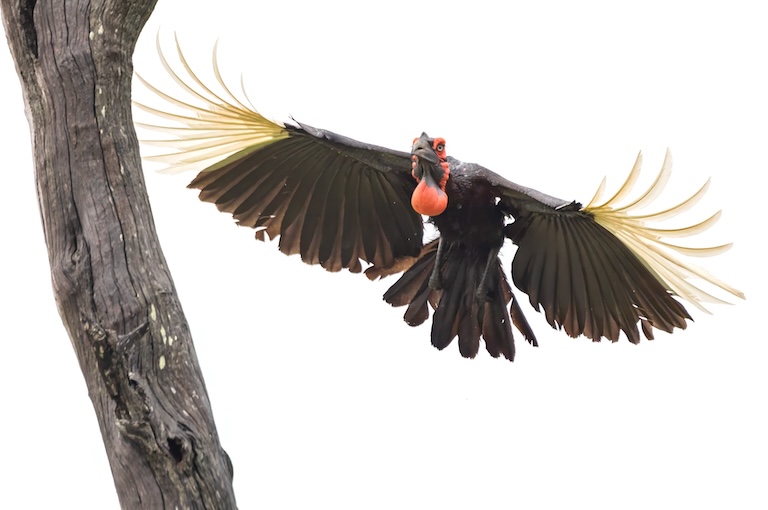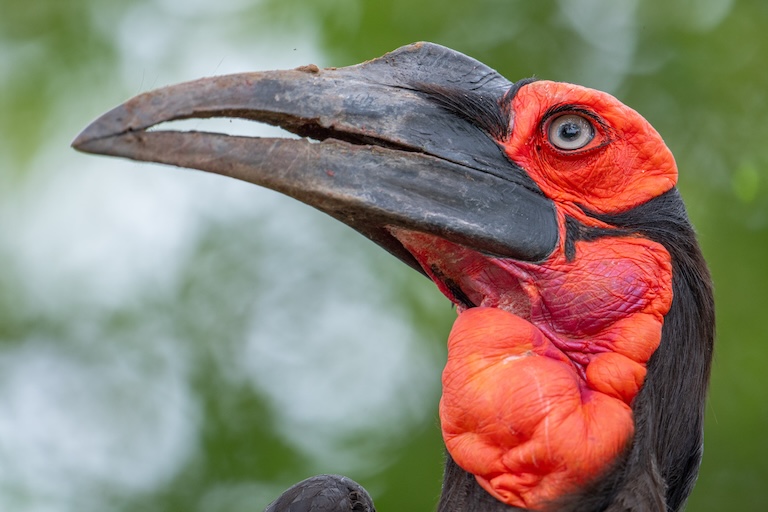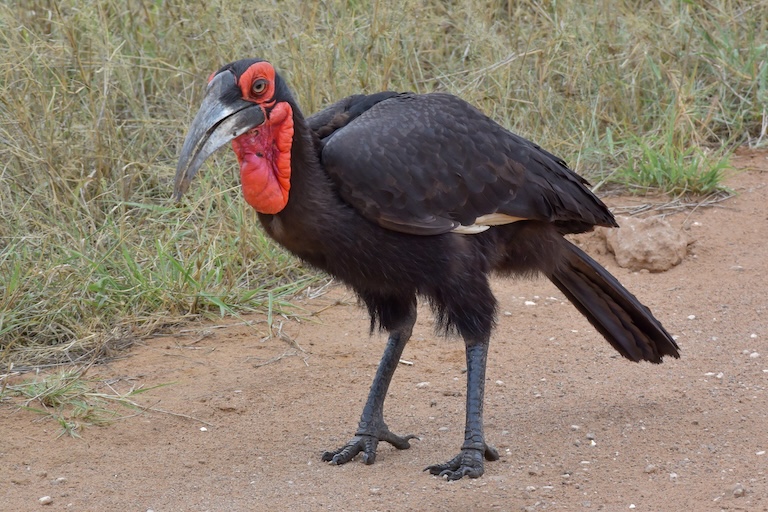Ground Hornbill Profile
Hornbills are some of the largest and most charismatic of the Old World tropical bird species.
Small species do sometimes get imprisoned by hyenas when a jealous and regicidal lion sells out his own kind but this is rare. In most cases they’re actually formidable and terrifying predators themselves, perusing the canopy for lizards and birds unlucky enough not to see them coming.
Their enormous heads are so cumbersome, that their first and second neck vertebrae are fused together to help support it, and species range from the relatively petite “Zazu” red-billed hornbill to a pair of archetypal hornbills so large they spend most of their time hunting on foot.
Named not only for being the crucial component in a Bucorvus burger, the ground hornbills are two remaining species of a once diverse family of apex, ground-based predators.

Ground Hornbill Facts Overview
| Habitat: | Savanna, scrub, rocky and grassy plains, woodlands. |
| Location: | Central and Southern Africa |
| Lifespan: | Up to 60 years in the wild, 70 in captivity |
| Size: | 130 cm (4 ft 3 in) long, (4 ft) wingspan |
| Weight: | Up to 4kg |
| Colour: | Mostly black, with red/orange wattles, cheeks in males, blue in females |
| Diet: | Invertebrates, snakes, lizards, rats, hares, squirrels or tortoises, some carrion |
| Predators: | Leopards, crorodiles |
| Top Speed: | 29 km/h (18 mph) |
| No. of Species: | 2 |
| Conservation Status: | Both species are Vulnerable (IUCN) |
Ground hornbills are known across their range as thunder birds by native peoples.
These huge, recognisable birds represent the early lineage of a diverse and global order; a pair of species descended from the African ancestors of all modern hornbills, once surrounded by family members, now the only two left of the Bucorvidae family.
Unlike other species, these two hunt on foot, yet they’re nimble enough to be able to fly, and do so to roost in trees at night.
They’re good parents, if a bit noisy, but the road to adulthood is rough for a hornbill, and their natural challenges are compounded by destructive human development.
Interesting Ground Hornbill Facts
1. They’re lonely
Recent studies have discovered that ground hornbills are a distinct lineage from the rest of the hornbills in the Bucerotiformes order.
In fact, this family diverged around 54 million years ago from the rest of the hornbill lineage, making them thoroughly ancient and tantalisingly close to the Cretaceous predators they would have been just 12 million years prior. 1
2. But they can fly
Velociraptors were essentially flightless birds, so in this instance, the hornbills outclass even them. But these birds do have some other similarities in the way they hunt on foot. They have long, powerful legs, and short toes that allow them to spend around 70% of their time on the ground, where they hunt and forage for anything edible.
But these are capable aviators and can fly up to 29 km/h, which allows them to both roost and nest in trees.
These are opportunistic feeders but prefer to eat other animals where possible. A large Southern ground hornbill has no trouble eating a small monkey from the canopy and uses its huge, curved beak to slice food up before swallowing it. 2

3. They’re cooperative breeders
Mating involves the same wattle inflation as in many bird species, but after all that bluster, successful breeding pairs are highly unusual in their behaviours.
Ground hornbills are behaviourally very different from their relatives, and one of the most obvious ways is in how they look after their young.
Cooperative breeding involves non-parental members of the community looking after the young of the group. Nobody’s really sure how and why it evolved, but it appears prevalent in hornbills, and ground hornbills are some of the best at it. But this doesn’t make the chick’s life any easier in the first days of life. 3
4. Firstborns are brutal
Ground hornbills will lay a small clutch of eggs, separated by a few days each. Newly hatched chicks come out one at a time, and the first, 70g killer will grow the fastest, making sure to steal as much food as it can at the expense of the others.
Anyone not out of the egg fast enough will starve to death after a few days, leaving only the strongest chick in the nest. 4
5. They’re loud
There are some suggestions that cooperative breeders are more social and perhaps more intelligent, and the Southern ground hornbill is certainly a vocal animal.
Not only do they talk a lot, they boom. Their calls can be heard from 3km away, and help communicate to friends and enemies whose territory is where.
This call sounds like something straight out of the Cretaceous; something that immediately screams Parasaurolophus.
Such a loud call is also an intimidation tactic to any would-be predators that might be stalking through the brush. 5
6. They’re apex predators
But in many locations, the ground hornbills are the most powerful predator. This gives them huge ecological significance as population control, and their large size and importance to the community are things that have not gone unnoticed by the local human populations.

7. Hunters use their heads for luck
Humans don’t appear to care for the meat of the ground hornbill, so they’re not usually hunted for food but they are killed for trophies.
Local cultures commonly consider these species a symbol of strength and power, or good luck. Their voices are said to be the calls of the ancestors and are mimicked in some villages as ceremonial performances.
In some areas, their severed heads are worn around the neck to aid hunters in the stalking of their prey. 6
8. Human development is a huge problem
Both species are listed as Vulnerable on the IUCN Red List, and their biggest threat comes from the destruction of viable habitats. But climate change, too, poses a significant danger to these species, which struggle with temperatures above 26oC.
This is compounded by the fact that they’re killed for rituals to deter drought, which is something that’s becoming more common across their ranges.
Collisions with powerlines are another common cause of mortality, and the slow reproduction rate of this long-living bird may make it hard to adapt or recover quickly.

Ground Hornbill Fact-File Summary
Scientific Classification
| Kingdom: | Animalia |
| Phylum: | Chordata |
| Class: | Aves |
| Order: | Bucerotiformes |
| Family: | Bucorvidae |
| Genus: | Bucorvus |
Fact Sources & References
- Don Roberson, “GROUND-HORNBILLS Bucorvidae”, Creagrus Monterey Bay.
- “SOUTHERN GROUND-HORNBILL”, Sanbi.
- Juan-Carlos T. Gonzalez (2013), “Environmental stability and the evolution of cooperative breeding in hornbills”, The Royal Society.
- “Bucorvus abyssinicus northern ground hornbill”, Animal Diversity Web.
- “Southern Ground Hornbill · Bucorvus leadbeateri”, xeno canto.
- “Bucorvus abyssinicus northern ground hornbill”, Animal Diversity Web.
